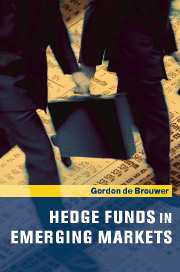Book contents
- Frontmatter
- Contents
- List of figures
- List of tables
- Preface
- 1 The issues
- 2 What is a hedge fund?
- 3 Hedge funds in east Asia
- 4 Hong Kong
- 5 Indonesia, Malaysia and Singapore
- 6 Australia and New zealand
- 7 Models of market dynamics
- 8 Inferring hedge fund positions from returns data
- 9 Looking forward
- References
- Index
2 - What is a hedge fund?
Published online by Cambridge University Press: 22 September 2009
- Frontmatter
- Contents
- List of figures
- List of tables
- Preface
- 1 The issues
- 2 What is a hedge fund?
- 3 Hedge funds in east Asia
- 4 Hong Kong
- 5 Indonesia, Malaysia and Singapore
- 6 Australia and New zealand
- 7 Models of market dynamics
- 8 Inferring hedge fund positions from returns data
- 9 Looking forward
- References
- Index
Summary
This chapter sets out definitions of hedge funds in terms of their legal structure and in terms of the strategies they pursue. It reviews evidence on the number and size of hedge funds, as well as their performance as investment vehicles.
The term ‘hedge fund’ was first coined in 1949 to describe a private investment partnership set up by Alfred Winslow Jones which ‘hedged’ the risk in its operations by buying what it perceived to be undervalued stocks and ‘short selling’ (Box 1) what it perceived to be overvalued stocks, with the combination varying over time as Jones' assessment of market conditions changed.
Box 1: Short-selling
Short-selling is the sale of an asset, such as a bond, equity or foreign currency, that the vendor does not own. The vendor first borrows the asset from another party, with the promise of repaying it back at some future time, and then sells it. If the price of the asset has fallen by the time the vendor is due to repay it to the lender, then he can buy it back in the market for less than he initially sold it. The profit is the selling price less the buying price and the cost of borrowing the asset.
- Type
- Chapter
- Information
- Hedge Funds in Emerging Markets , pp. 9 - 40Publisher: Cambridge University PressPrint publication year: 2001



